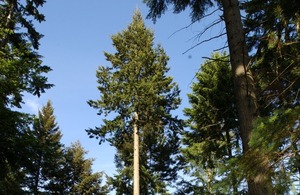Homegrown seed to kickstart new generation of Douglas fir trees
Groundbreaking breeding programme to develop new generation of British grown Douglas fir trees after decades of research.

Credit: Forestry Commission
Douglas fir is native to North America and has been used in British forestry for over 100 years. Demand is rising rapidly and currently; we import much of our seed from the USA or France and there is a need to develop a strain that is specialised for British conditions.
For decades there have been incomplete¬Ýattempts to develop British Douglas fir seed sources suited to our conditions, but now a government funded¬Ýproject led by the Conifer Breeding Cooperative has overcome this and will grow the next generation of Douglas fir from British tree seeds.
The project involved the selection of 200 visually superior trees from the best Douglas fir plantations in Britain, as well as 40 genetically superior trees from long-term experiments managed by Forest Research.
This selection of outstanding Douglas¬Ýfirs will¬Ýnow be used by the Conifer Breeding Cooperative and Forest Research¬Ýas breeding stock to produce British Douglas Fir seed. The chosen trees will be copied by grafting cuttings onto rootstocks, after the grafted plants will go into seed orchards.¬ÝIn several years, once¬Ýseeds are available, they will be supplied to forest nurseries to grow the first genetically improved British Douglas fir trees.¬Ý
Richard Whittet, Head of Tree Breeding at Forest Research and Chair of the¬ÝConifer Breeding Cooperative, said:‚ÄØ‚Ä�
‚ÄúWe have selected a new generation of Douglas fir trees for breeding, based on their adaptation to the British climate and timber properties which is an important step forward for the resilience of our nation‚Äôs trees.‚Ä�
‚ÄúThis achievement is the result of decades of work by Forest Research and our domestic and international partners. Collaboration has enabled us to get things done on the ground and harness new technologies, such as the low-cost DNA marker array for quality assurance.‚Ä�
Sir William Worsley, Chair of the Forestry Commission, said:
¬Ý‚ÄúWe are facing a changing climate and biodiversity decline, with trees playing a significant role in mitigating some of the worst impacts.
‚ÄúWe rely too heavily on timber imports in the UK and if we are to strengthen own domestic supply then this type of science will play a huge role in the future. Therefore, there has never been a more crucial time to invest in domestic tree-planting‚Ä�.
A DNA fingerprint ‚Ä� which shows the genetic make-up of each tree ‚Ä� has¬Ýalso¬Ýbeen taken of each tree by Oxford University.¬ÝThis is the first time this technique has been used at such an early stage of a tree breeding programme in Great Britain. The DNA fingerprint is used as a quality-control tool to track and evaluate the tree‚Äôs parentage and enable traceability. This¬Ýimportant data will help advance the project.¬Ý
Douglas fir is a desirable timber-producing tree for Britain and this step forward to develop a resilient British population will ensure better yield for our domestic timber industry. Fast growing conifers such at this sequester carbon more quickly than slower growing species.¬Ý Using timber in construction, in place of other non-renewable materials, is one of the best ways to reduce emissions from buildings. It also ensures that carbon is locked up long-term.
Today’s development will help bolster the domestic timber industry as part of the Government’s critical mission to make the UK clean energy superpower and ensure we are resilient to a changing climate. This is the latest government innovation in the fight to protect our nation’s trees and woodlands.
The project partners involved are¬ÝConifer Breeding Coop, University of Oxford, and Forestart and it has been funded by the Department of Environment Food and Rural Affairs.
Additional Information:¬Ý
- The trials were first established in the 1990s as part of a European Commission project with several international partners including Britain, France, Germany, Italy, Spain and Belgium